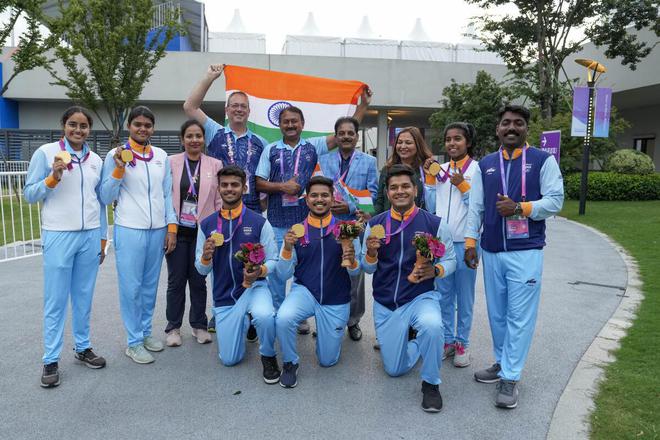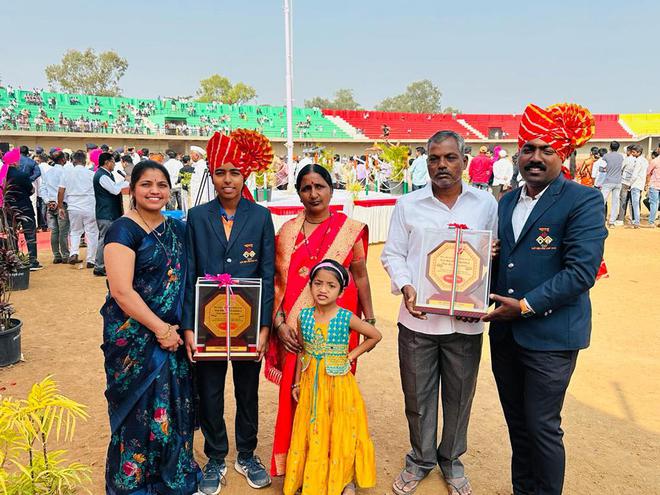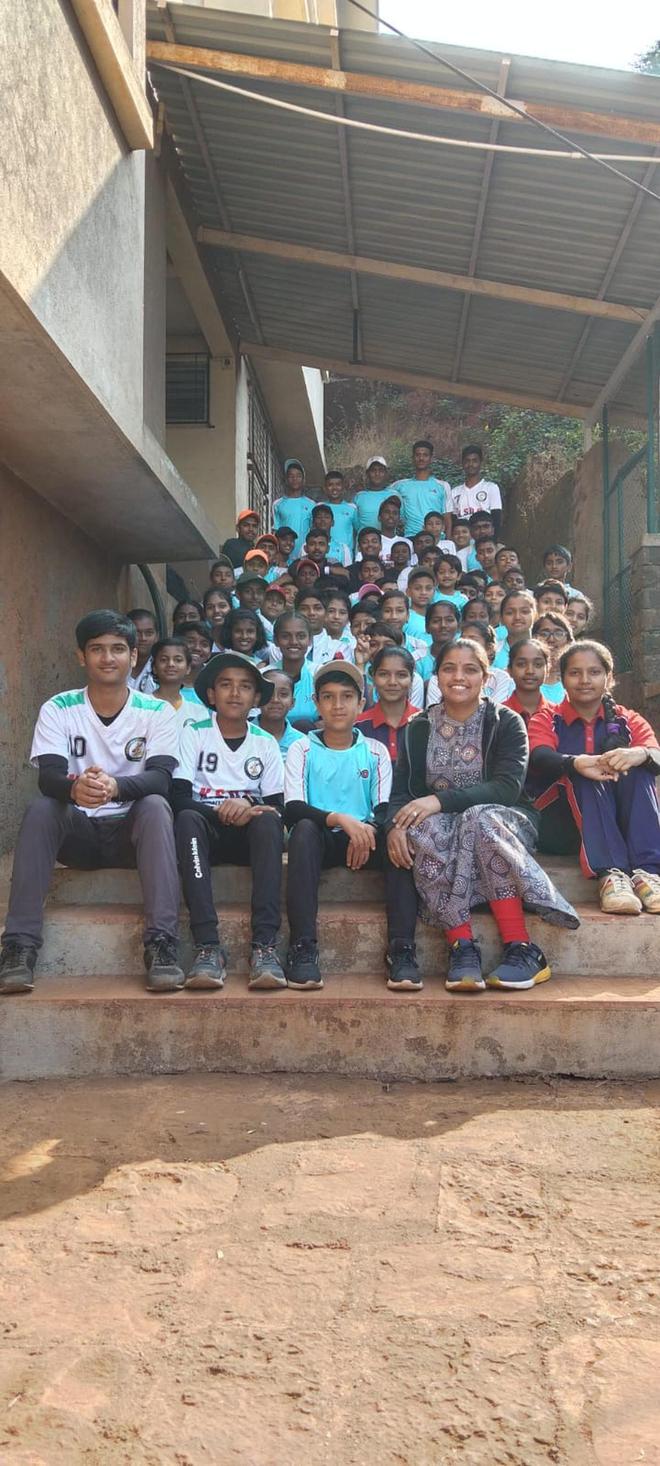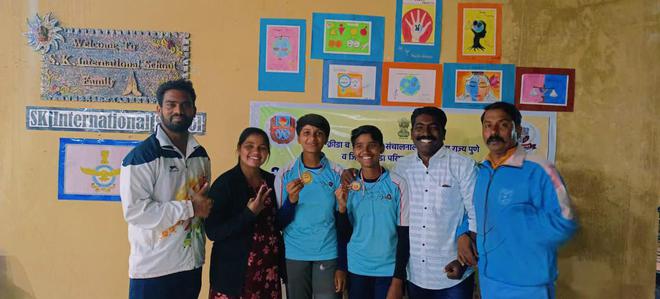Growing up in rural Maharashtra, Pravin Sawant was 17 years old when he became obsessed with archery. Lack of resources prevented Sawant, who worked as a ward boy in a hospital as a youngster, from becoming the archer he wanted to be, but now is the time for him to take a bow as a coach responsible for one of India archery’s greatest campaigns at the Asian Games.
The 31-year-old from Satara, who is now a Maharashtra Police constable, can be credited for being the hand behind seven medals in compound archery — five of them gold — at Hangzhou in China.
On the night before the final day of the archery competition, Sawant went to bed in the Games Village with one dream. With India on the cusp of winning a historic 100 medals, Sawant hoped the honour would go to one of the students from his academy.

The two archers from his Drushti Archery Academy, Ojas Deotale and Aditi Swami, fulfilled their part of the deal. Aditi, 17, won bronze to take India’s tally to 96. About a half-an-hour later, during which two more medals had been added to India’s tally, Ojas won gold in the men’s individual compound event to bring up medal number 99. The 100th was not to be (that went to the women’s kabaddi team), but Sawant ended up with an oversized contribution to India’s tally.
Ojas won three gold medals in the individual, mixed team, and men’s team events, while Aditi won gold in the women’s team event and bronze in the individual category.
Sawant was there at the culmination of the campaign, standing right behind Ojas when he won gold in the men’s individual category to become the first Indian man to win three gold medals at a single edition of the Asian Games.
“Mere khud ka dream tha archery khelne ka. Woh nahin hua (It was my dream to compete in archery. That could not happen), but as a coach, I feel happy,” said Sawant over a call from Hangzhou, with a huge smile across his face.
Burning desire
The son of manual labourers in Wai, a village a few kilometres off Satara town in southern Maharashtra, Sawant didn’t harbour great ambitions growing up. “My parents did what they could, but when you are poor, you cannot think too big,” he said.
Archery ambition was kindled, if only by chance when he saw the 2008 Olympics in Beijing on television. India had just the one representative in archery there: Recurve archer Mangal Singh Champia was second in qualifying before losing to eventual bronze medalist Bair Badenov of Russia. Sawant said he was smitten. But archery needs money. An Indian bow made of bamboo cost ₹3,000 and arrows cost ₹100 each. At the age of 17, Sawant started work as a ward boy at Suhas Pol Orthopedic hospital in Satara. The pay wasn’t great, about ₹1,500 a month. The work wasn’t always pleasant.
“We had to deal with medical waste, clean up the rooms. You had to apply dressing and give medicines. Sometimes, when the doctors were busy, we were told to set up IV drips even though that’s not something I had ever trained to do. I have even worked in an operating theatre,” he said.
But Sawant didn’t mind. With the money he earned he joined an archery academy near Satara. After 12-hour night shifts that ended at 7am, Sawant would make a 45km trip by bus to the academy and train on an Indian bamboo bow. “I didn’t get much sleep. I was just going from work to the range and shooting. Sach me pagal tha (I was truly mad),” he remembered.
Sawant had some ability. He won a national medal in the Indian bow category in 2011, but financial concerns were a constant companion. “I was thinking all the time, where do I get equipment from? How do I travel for competitions?”
Recurve archery was already an established event in India, so Sawant decided to pursue compound archery in the hope that he could secure a government job. “I bought a second-hand bow and started. I didn’t have the money, so, I took loans from anyone who would lend me money,” he said.
The gamble would pay off. Sawant eventually got the police job in 2011. He has never got a promotion. The salary gave him some breathing space. “I came from nothing. Considering how I would train in the morning and work at night, the police guard duty is nothing. It’s very easy,” he said.
Sawant did his job at Satara police headquarters, but remained obsessed with archery. He cannot say when he started working as a coach. “I think, even while I was shooting myself, I was always interested in how the compound bow works. I was always helping out other archers. Eventually I got into coaching. I can’t say when training archers became my main interest but I know I registered Drushti Archery Academy in 2017.”

Early days
Initially, he started coaching at Satara’s Shahu stadium. Owing to lack of space he moved around the city – from behind the Congress Committee Bhawan building to a space behind Saidabput hostel. The search for a permanent location would finally end after help from someone he knew since his ward boy days.
“When I was working at the hospital, I got to know Mahendra Kadam, a pharmacist. He used to tell me he admired me for my struggle to learn archery. Later, when I got into coaching, he sent his daughter to train with me. When he saw that I was looking for a place to train, he asked if I would want to use his field,” he said.
Kadam’s offer was a piece of farmland just outside Satara. It was used to grow sugarcane, but Kadam agreed to let Sawant start his academy there.
Drushti Archery Academy is surprisingly modest when you consider just how well its students have done. The facility has a shooting range with a target, a tin-covered shed for equipment, and another tin roof structure in which outstation students stay.
Where the work happens
Despite the humble facilities, Drushti Archery Academy has produced enviable results. “So many students have got medals from the state and national level. Many have got sports quota jobs as well,” said Sawant. Medals have been won at international level, too. Before the Asian Games, Ojas and Aditi made headlines when they won individual gold at the Archery World Cup in Berlin earlier this year. While Aditi has been training with Sawant from early in her career, Ojas joined in 2022 after struggling for success.
Ojas’ improvement from an archer who did not have a national medal to one who has swept the podium at the Asian Games is near miraculous. Yet, Sawant believes his coaching philosophy is fairly simple. “I’m mostly a self-taught coach. I only did my coaching diploma from NIS (National Institute of Sport) during the COVID pandemic. I am mostly a practical coach, I think. I teach them love for the sport. If you can teach them that, the rest comes by itself,” he said.
Sawant also helps in more practical matters. “I always struggled because I didn’t know anything about equipment or lacked finances. So, I help students get equipment, tell them about job openings, or if the government has any policy to buy equipment,” he said.
Coaching philosophy
Despite his results, Sawant doesn’t think he has any special coaching ability. “I think the reason my archers do well is because I have a bond with them. They should think I’m their friend and trust me. When we are together, we plan lunch and dinner. I need them to first think they are secure with me, archery comes later. It’s only after they trust me that I can work on technique and fine-tune their equipment. Every athlete is different, so you have to build bonds with each of them. Everyone’s competition temperament is different, so you have to deal with each athlete differently.” he said.
Sawant’s athletes and their parents second this. Ojas’ mother, Archana has experienced this. “Last year was the first time Ojas did not celebrate Diwali at home. Sawant sir said he wanted Ojas to stay and train in Satara. Later, we found out that Sawant sir had celebrated Diwali with Ojas at the academy itself. He had applied utane (a mix of Ayurvedic powders used on the first day of Diwali) and treated Ojas like a son. I will never forget that,” said Archana.
The friendly touch, however, comes attached with Sawant’s reputation for being strict. He says it comes from his police background. The coach does not corner any privileges, and makes sure to deal with the same privations as his students. “I stay in the academy just like each of the 40 students. I work with them in the morning, then go to work and return to train them in the evening. At night my family and daughter also stay under the same tin roof,” he said.
Some scale of Sawant’s devotion to his academy can perhaps be gauged from the fact that he named his firstborn daughter Drushti after his academy. Sawant became a father for a second time earlier this month, a second daughter. He left his wife, Shaili, and three-day-old baby to travel with the Indian team to Hangzhou.

Some of Sawant’s obsession with the sport has even rubbed off on his wife, who had no sporting background. “She was working in the academy on the day she had her delivery. Now, within 10 days of the delivery, she’s back helping the students. I have made her also mad about archery,” he laughed.
Some of his passion is shared by his police seniors. “I am a constable, but I get a lot of respect at work because they know I am an international coach. They are genuinely helpful. If I am on guard duty and a student has a problem, they immediately adjust my shifts so that I can go and help,” he said.
Fight continues
While his work as a coach gives him joy, Sawant admits things aren’t always easy. As a coach, he’s not eligible for any sports performance-based promotion. He has also taken loans to set up his academy. Although the state government promised large awards after his students won gold medals at the world level, he is yet to see any of that money.
“I am under about ₹15 lakh of debt. I spent it to set up my academy. I have been given the fields to practise on, but I still have to pay rent. I have mortgaged my wife’s jewels and taken loans from a lot of banks,” he said.
He doesn’t have any regrets, though. “I got into coaching not because I thought I would become rich, but because I felt I could produce international archers and give them what I lacked. I never got good coaching. So, I want to be someone who gives 100 percent.”

“There’s no reason why there can’t be more coaches like me in India. I think a lot of people make excuses that they don’t have this or that. I think, sometimes, we look for ways to justify why we can’t do something. But the most important thing you need is passion,” he said.
Sawant’s passion for archery started at the Olympics and his burning desire is to produce Olympic champions, but there is a roadblock. Compound archery is still not part of the Olympics programme. World Archery has sent an application for this form of the sport to be included in the 2028 Los Angeles Olympics. Compound archery is popular in the US and Sawant is hopeful it gets included. “I won’t be satisfied until I actually produce an Olympic champion,” he said.






